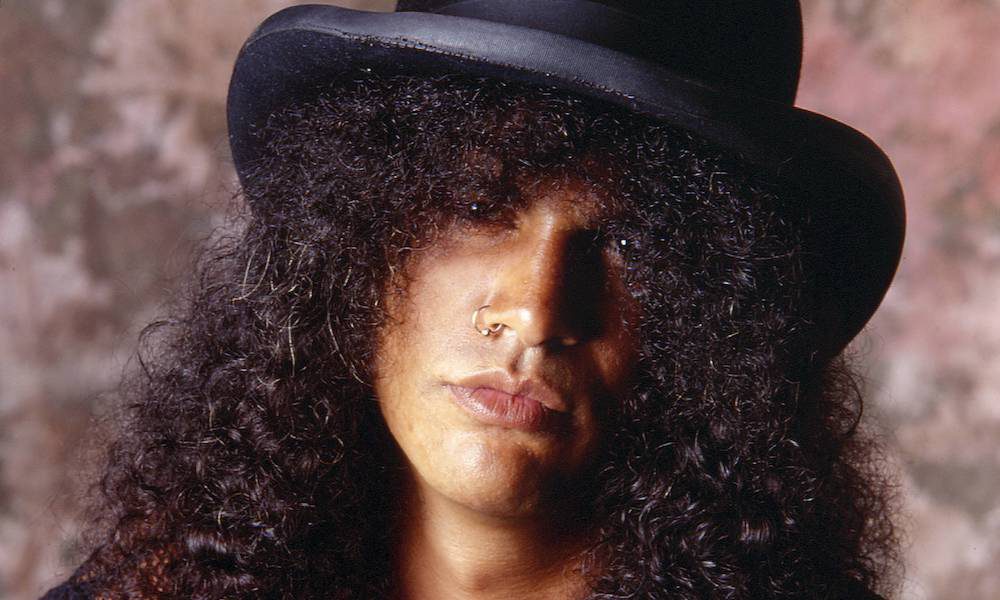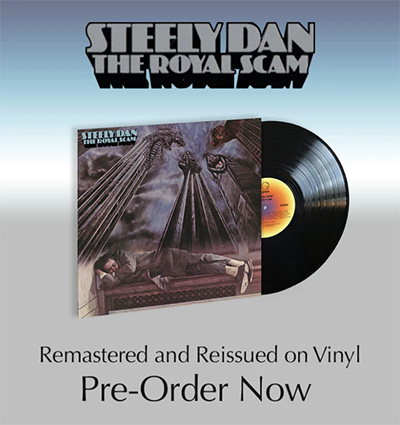Best Slash Solos: 20 Iconic Moments From The GNR Guitarist
The pyrotechnic guitarist is among the last in a dying breed of rock legends.

Effortlessly iconic in every way possible, the rock’n’roll legend known to us all as Slash has been in the “guitar god” stratosphere since the world awoke to the opening chords of “Welcome To The Jungle,” from Guns N’ Roses’ revolutionary masterpiece Appetite For Destruction, back in July 1987. The striking image of his jet-black curly hair, crowned with signature top hat and low-slung Gibson sunburst, ignited a love affair between fans and media critics the world over, who hailed Slash as one of the last great rock’n’roll pirates of a generation.
Born Saul Hudson, on July 23, 1965, to mother Ola Hudson (an African-American costume designer for the likes of Ringo Starr, John Lennon and David Bowie) and father Anthony Hudson (whose profession as an artist saw him design album covers for recording greats such as Neil Young and Joni Mitchell), at the age of five, Saul moved from his home in England’s Stoke-on-Trent to LA. Unable to concentrate on just any one pastime, he attempted to master many activities, including BMX racing, before discovering his love for playing the guitar.
Listen to Slash’s best solos on Spotify.
It seemed inevitable that, from a very young age, Saul would find his destiny within the tempestuous world of rock’n’roll. His parents’ professions and exposure to their eclectic musical tastes ensured there was plenty of music at home, and the 14-year-old Saul would pluck his guitar strings to crackling records, reportedly practicing for up to 12 hours a day.
Saul joined his first band, Tidus Sloan, in 1981, but they had no singer – and about as much impact. A brief stint with Road Crew followed, before he joined Hollywood Rose, which bore the first fruits of his partnership with vocalist William Bruce Rose, aka Axl Rose. Subsequently launching his iconic persona, Saul would be introduced to the world simply as “Slash”, the enigmatic guitarist who smashed through the glitter and barbed wire of the late 80s LA glam rock scene.
A year later, with Axl, guitarist Izzy Stradlin, bassist Duff McKagan, and drummer Steven Adler, he would emerge from the Sunset Strip gutter as part of a local band known simply as Guns N’ Roses. Appealing to the late 80s underground LA rock scene, GNR’s self-released Live ?!*@ Like A Suicide EP made a significant impact in 1986, with sales exceeding 10,000 copies. The band’s fate was set in stone when they inked a worldwide deal with Geffen Records, who quietly reissued the EP to cultivate support in preparation for Guns’ legendary debut album.
Quickly becoming one of the pre-eminent guitarists among the American hard rock, underground and alternative music scenes, Slash’s style of playing was a breath of fresh air during a time when compressed rigid guitar tones were rampant, thanks to the craze for thrash metal and the self-professed virtuosos on the Hollywood/Sunset Strip circuit. Yet Slash was the real deal – and had the credentials to prove it.
Appetite For Destruction
During the recording of Appetite For Destruction, Slash’s relentless search for the ultimate rock’n’roll guitar tone created tension between him and producer Mick Clink. Reportedly using a ’59 Les Paul replica and a rental modified Marshall JMC guitar head (which he claimed was stolen because he loved the sound so much), Slash’s performances on the album nevertheless remain unmatched by any of his peers, as he beats a path through rock’n’roll history with each track.
From the gritty intro to “Welcome To The Jungle” to the neck-pickup-driven opening riff on “Sweet Child O’ Mine,” each slab of Guns’ punk-driven hard rock comes at the listener like a biker with a broken bottle and a bad attitude. Slash’s very style and guitar playing evokes an array of sonic flavors, ranging from Chuck Berry, Jimi Hendrix and Stevie Ray Vaughan, to Jimmy Page and Joe Perry. His delivery and unique swagger, however, were truly iconic; his ability to “let the instrument do the talking” is in abundance on classics such as “Nighttrain” and the frenetic “Mr. Brownstone,” which drips like pure honey from a rock’n’roll hive.
Appetite offered an alternative to the established sound of West Coast hard rock. With a visceral attack on the senses, Axl and co snarl and bash their way through classics the likes of “It’s So Easy” and “Rocket Queen,” before the anthemic “Paradise City” sees Slash switch between singalong melodies and epic, fret-bothering solos with ease. GNR were on top of the world, and Slash the very embodiment of hard rock as it moved from the 80s to the 90s.
Use Your Illusion
The years passed and anticipation for Appetite’s follow-up grew; when Use Your Illusion I and II finally emerged, in 1991, Axl, too, stepped forward as one of the great singer-songwriters of his generation. “November Rain” remains a perfect example of GNR’s new direction and stands as a pinnacle of the band’s legacy, with grandiose arrangements and one of Slash’s most iconic guitar solos.
The Use Your Illusion era displayed a vast array of material across two albums (including “Estranged” and lead Illusion single “You Could Be Mine”), with complexity in both production and instrumentation reaching gargantuan proportions, a reaction, in part, to massive expectations from the world’s media. This line-up of the band soon imploded, leading to the release of Slash’s first solo outing (under the guise of Slash’s Snakepit). 1995’s It’s Five O’Clock Somewhere was marked out by album closer “Back And Forth Again,” and a follow-up album, Ain’t Life Grand, emerged in 2000. Slash’s newfound freedom saw him harness his creative energy with impressive rhythm structures and instantly catchy, yet complex guitar solos loaded with emotion. Working very much as a solo artist, Slash invited a host of guest musicians to appear on both Snakepit albums, including then GNR members Gilby Clarke and Matt Sorum, along with Mike Inez (Alice In Chains) and Eric Drover (Jellyfish).
Contraband and Libertad
Constantly writing and creating music, Slash’s continuing adventures in the studio saw an unexpected collaboration with Matt Sorum and fellow former GNR member Duff McKagan, alongside Stone Temple Pilots vocalist, the late Scott Weiland, and Wasted Youth guitarist Dave Kushner. Collectively known as Velvet Revolver, the rock supergroup dominated the music press upon the release of their 2004 debut album, Contraband, and its 2007 follow-up, Libertad.
Packed with songs that displayed powerful chemistry and visceral attack in equal measure, the record’s instant success saw Slash climb higher up the ladder of esteemed guitar heroes, thanks to his trademark grinding tone and incomparable guitar solos, as exemplified on tracks such as “Slither’ and “Sucker Train Blues,” from VR’s debut, and “She Builds Quick Machines” from Libertad. Velvet Revolver’s short-lived career came to a sudden halt in March 2008, but it wasn’t long before Slash returned. His self-titled 2010 album featured was a “who’s who” of rock royalty guests, including Iggy Pop (who guested on “We’re All Gonna Die”), Motörhead’s Lemmy, The Cult’s Ian Astbury, Soundgarden’s Chris Cornell, Wolfmother’s Andrew Stockdale and Myles Kennedy of Alter Bridge.
Apocalyptic Love and World on Fire
Slash and Kennedy subsequently formed a formidable bond that resulted in two more albums, 2012’s Apocalyptic Love and 2014’s World On Fire, both of which were credited to “Slash Featuring Myles Kennedy And The Conspirators”. Both also featured the unmitigated ferocity of Slash’s musicianship, raising the bar with the former’s stand-out tracks “Anastasia” and “Hard And Fast,” and the latter’s “Wicked Stone,” “Bent To Fly” and the title track. Though he’s assumed various different musical incarnations, the consistency of Slash’s craft as a performing and recording artist remains undisputed. Never known to hog the spotlight, nor seek narcissistic validation from his adoring fans, the man under the hat simply wants to play rock’n’roll. As long as that can happen, the world will be a better place.
Looking for more? Discover the Best Guns N’ Roses Songs: 20 Tracks To Satiate Your Appetite.













David Parker
May 10, 2016 at 8:10 pm
This article is a bit over-the-top in its breathless admiration of everything Slash (particularly the latter years), but it’s a very nice summation of the man’s career so far. I’ve always loved his pure, gimmick-free playing. So much emotion. Definitely one of the greatest guitar players of all time.